
THE Pajero Sport is based on the Triton ute that arrived early in 2015 and was a finalist at last year’s 4X4OTY.
Aside from the body and the coil-spring rear suspension, the notable change from the Triton is an eight-speed automatic in place of the Triton’s five-speed auto. There’s no manual in the three-model range and all have Mitsubishi’s now unique Super Select 4x4 system that offers the functionality of full-time 4x4 but with the option of 4x2. Otherwise it’s Triton engine, Triton front suspension and a shortened and modified Triton ladder-frame chassis.
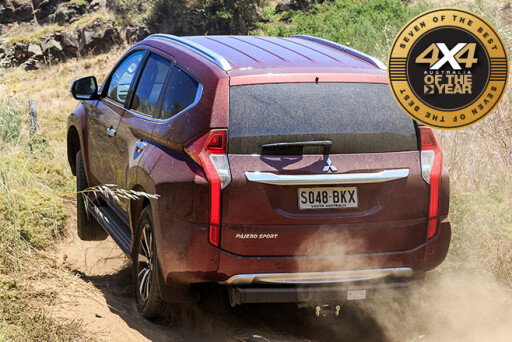 Our test vehicle was the Pajero Sport GLS. The more expensive Exceed gains autonomous braking, blind-spot monitoring, external view cameras and a rear DVD system. Below the GLS is the GXL, which loses the third-row seats but gains payload and luggage space.
Our test vehicle was the Pajero Sport GLS. The more expensive Exceed gains autonomous braking, blind-spot monitoring, external view cameras and a rear DVD system. Below the GLS is the GXL, which loses the third-row seats but gains payload and luggage space.
TOURING
With its well-sorted suspension, strong engine, super-smooth eight-speed auto
and selectable full-time 4x4 system, the Pajero Sport GLS proved to be a comfortable touring wagon. It’s also very well equipped, especially considering its sub-$50K asking price.
The soft suspension offers compliance on bumpy back roads and when driving on gravel. However, the Pajero Sport does exhibit pronounced body roll when cornering. Nevertheless, the fact you can engage full-time 4x4 on sealed or unsealed surfaces ensures there’s plenty of traction whenever you need it.
 The Pajero Sport proved economical on test, recording an average fuel consumption figure of 11.2L/100km, but with a smallish 68L fuel tank safe touring range is limited to around 550km.
The Pajero Sport proved economical on test, recording an average fuel consumption figure of 11.2L/100km, but with a smallish 68L fuel tank safe touring range is limited to around 550km.
TRAIL DRIVING
The Pajero Sport’s aforementioned soft suspension results in a good ride over bumpy off-road tracks. Ground clearance is adequate for most tracks, although the rear overhang is compromised by the location of the spare wheel and furthermore when an OE towbar is fitted, as it was to our test vehicle.
The transmission’s paddle shifts are mounted to the steering column rather than the wheel, so you don’t have to fumble around looking for them when the wheel is turned, but the Pajero Sport was occasionally reluctant to shift down when manually prompted to do so.

The rear diff lock (standard on GLS and Exceed) engages quickly but once selected the traction control system is disengaged on both axles, so in many off-road situations you’re better option is to leave the rear diff open so you can take advantage of the traction control.
SET-PIECE HILL CLIMB
With the rear diff lock engaged, the Pajero Sport found the going tough on the set-piece hill climb. Rear-wheel travel is acceptable, but there isn’t a lot of travel up front, and without any electronic intervention the front wheels were left scrabbling for traction over even moderate undulations on the hill.
For its second attempt at the hill climb, the rear diff lock was disengaged to
enable the electronic traction control system to do its thing; the Pajero Sport made it further up the climb in this configuration, but the driving line had to be altered to avoid the biggest holes in the track for it to eventually crest the hill.
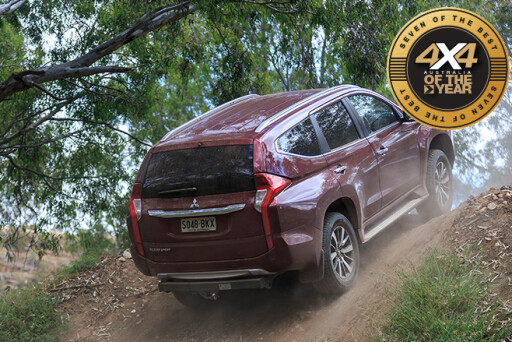 The Pajero Sport’s impressive low-range gearing meant descending the set-piece hill climb was easy, with no need to apply the brakes or engage the HDC; very good stuff for an auto!
The Pajero Sport’s impressive low-range gearing meant descending the set-piece hill climb was easy, with no need to apply the brakes or engage the HDC; very good stuff for an auto!
CABIN, EQUIPMENT AND ACCOMMODATION
It’s not the top-spec Pajero Sport, but the GLS is still very well-equipped and comes standard with features including leather seat trim, electric seat adjustment, dual-zone climate-control air-conditioning, Apple CarPlay and Android Auto connectivity, and keyless entry.
The front seats are supportive and comfortable, but all of the 4X4OTY judges complained about the design of the centre console which encroaches on leg room and makes the cockpit feel cramped.
Comfortably accommodating three adults across the second-row seat is a big ask. There’s not enough shoulder room and the outer-seat occupants feel as though they’re leaning towards the centre. Meanwhile, the centre passenger will be sitting atop his or her own seatbelt buckle.
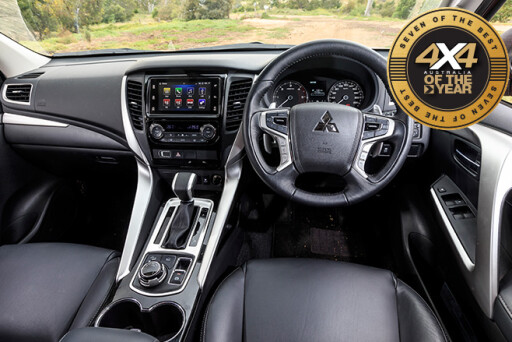 With a tumble fold design, access to the third-row seats is good, there’s reasonable legroom and there are air-conditioning vents and cup holders, but the child-seat anchor points that protrude from the roof compromise headroom.
With a tumble fold design, access to the third-row seats is good, there’s reasonable legroom and there are air-conditioning vents and cup holders, but the child-seat anchor points that protrude from the roof compromise headroom.
With the third-row seats folded into the floor, the Pajero Sport has a good-size cargo area, but the cargo-tie-down points are not particularly strong, and there are only two of them.
PRACTICALITIES
All Pajero Sport models are equipped with 18-inch rims shod with 265/60R18 Dunlop GT AT20 rubber, which is now almost the standard size for this class.
While the air intake is positioned up high up through the Pajero Sport’s inner guard, the alternator is down at the midpoint of the engine bay where it’s more susceptible to a mud bath in extreme conditions. All other electrics are located up high, and there’s plenty of space for those who wish to fit a second battery or an air compressor in the engine bay.
If you get stuck in your Pajero Sport, you’ll be pleased to know it’s fitted with decent recovery points front and rear.
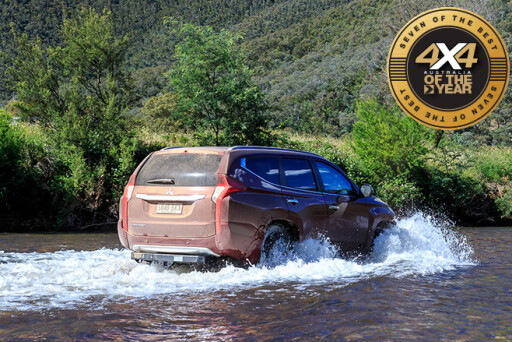 SUMMARY
SUMMARY
The Pajero Sport GLS packs plenty of equipment and features, yet is priced lower than many of its direct competitors. It delivers good on-road performance, comfortable ride quality and reasonable off-road capability.
At the end of the week’s testing, the Pajero Sport pleasantly surprised everyone, but none of the judges were impressed with the console, which results in a cramped cockpit feel.
TOUGHEN UP
Tough Dog offers a 20mm lift using either 41mm non-adjustable foam cell or the nine-stage adjustable shocks option. The front end is susceptible to changes in weight so TD has developed three different springs for different weights – one for standard trim, one for vehicles with a bullbar, and a third for vehicles with both a bullbar and winch. It has also developed 0-300kg and 300kg+ constant load springs for the back. Price ranges from $1340 to $1680, depending on options selected.
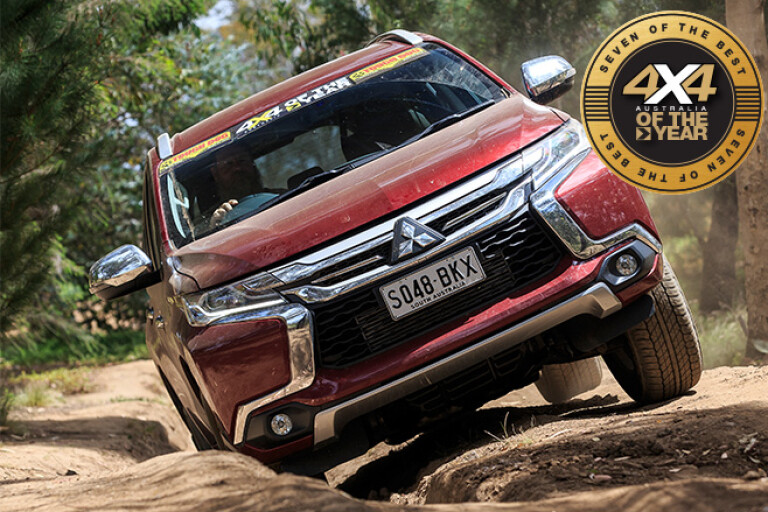
SPECS
Engine: 2.4-litre 4-cyl turbo-diesel
Max Power: 133kW @ 3500rpm
Max Torque: 430Nm @ 2500rpm
Gearbox: eight-speed automatic
4x4 system: dual-range full-time (+2WD)
Crawl ratio: 45.9:1
Tyre spec: 265/60R18 110H
Kerb weight: 2070kg
GVM: 2710kg
Payload: 640kg
Towing capacity: 3100kg
GCM: 5400kg
Fuel tank capacity: 68 litres
ADR fuel claim: 8.0L/100km
Price: $48,500
*Price exclude on-road costs.
MORE 4X4 OF THE YEAR
 HOME: 4X4 OF THE YEAR 2017
HOME: 4X4 OF THE YEAR 2017
The seven most interesting 4x4 vehicles of 2016 get together for a week to determine the 4x4 Of The Year.
 THE FINALISTS
THE FINALISTS
Meet the seven most interesting 4x4 vehicles of 2016 battling it out to be crowned 4x4 Of The Year.
 THE RESULTS
THE RESULTS
Only one of the seven best 4x4s from 2016 can be crowned 4x4 Of The Year 2017
 4X4 OF THE YEAR HOME
4X4 OF THE YEAR HOME
Finding Australia's Best 4x4s

COMMENTS